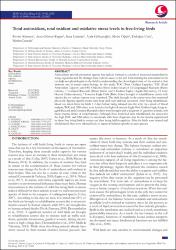Total antioxidant, total oxidant and oxidative stress levels in free-living birds

Göster/
Erişim
info:eu-repo/semantics/openAccessTarih
2023Yazar
Sönmez, EvrimErgen, Arzu Gürsoy
Çenesiz, Sena
Gökçeoğlu, Ayris
Öğün, Metin
Uzlu, Erdoğan
Çenesiz, Metin
Üst veri
Tüm öğe kaydını gösterÖzet
Antioxidants provide protection against free radicals formed as a result of increased metabolism in living organisms and the damage these radicals cause to the cell. For this reason, determining the antioxidant levels can help eco-physiologists in the field in understanding the physiological state of the animal at that moment and in conservation biology. In this study, TAC, TOC and OSI values of 12 Long-legged Buzzards (Buteo rufinus), 7 Common Buzzards (Buteo buteo) and 6 Golden Eagles (Aquila chrysaetos), 15 Grey Herons (Ardea cinerea), 7 Eurasian Eagle Owls (Bubo bubo) brought to rehabilitation centre with injuries due to various reasons were examined. First of all, physical examinations of the birds brought to the centre were made. They were then kept in species-specific rooms until recovery. After they were rehabilitated, blood was taken from the birds 1-2 days before they were released into the nature. As a result of blood analysis, TOC and OSI values were found to be high in Eurasian Eagle Owl, Golden Eagle, Long-legged Buzzard and Common Buzzards which were brought with a diagnosis of gunshot wounds, soft tissue trauma, femur or wing fractures. Although these birds were rehabilitated, the reason why TOC and OSI values were high in the individuals brought with these diagnoses may be the trauma experienced by these free-living birds and their subsequent detention in captivity. After the birds were treated and rehabilitated, they were released back to nature in habitats specific to each species.
Cilt
8Sayı
2Bağlantı
https://doi.org/10.24880/maeuvfd.1226362https://search.trdizin.gov.tr/yayin/detay/1195987
https://hdl.handle.net/20.500.12462/13958

















